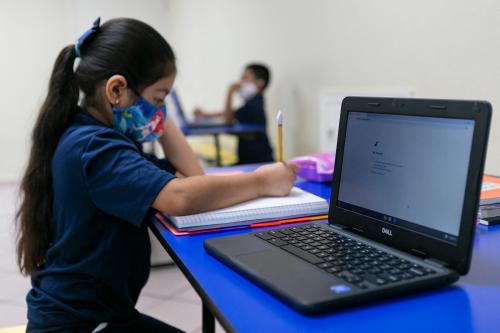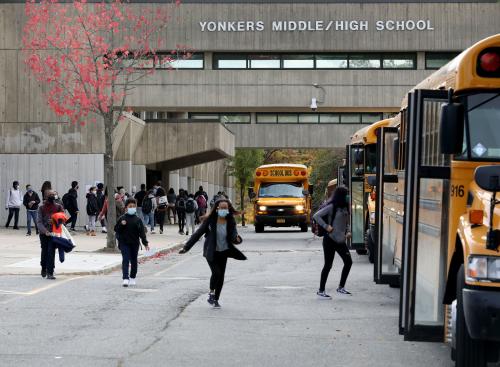Always a brutally hard job, the superintendency is tougher and riskier than ever thanks to COVID-19. Superintendents have resigned in Seattle and the three largest Colorado school districts. Another in Paradise, Arizona, has quit after being harassed and threatened by parents that were angry over his decision to close schools. Boston Superintendent Brenda Casella is the latest big-city superintendent to suffer a union vote of no confidence.
Even without the coronavirus crisis, superintendents must overcome myriad challenges. Incumbents are pushed in contradictory directions by school board members; bullied by mayors and governors; sued by some parents and deserted in favor of private schools by others; at sword’s point with unions; and awaiting news about how much their state funding will be cut.
But somebody has to do it—and the job is more important now than ever. The need for superintendent leadership is amplified in times of crisis. Students and communities need someone to bring clarity to chaos, make decisions, and respond to surprises. If superintendents don’t lead district responses, no one else can.
Executive jobs in the public sector are always insecure and underpowered. But officials who lack power for unilateral action can still get things done. This is possible if superintendents get outside the narrow confines of their administrative responsibilities and act as political leaders, seeking public understanding and support of their strategies and collaborating with city government and civic groups on child welfare, youth development, and workforce readiness.
In the current crisis, superintendents are no longer just administrators of routine-following organizations. They need to navigate a shifting environment where new demands are emerging all the time. As we observed in our study of school district responses to the pandemic, districts were forced to form new alliances with social service agencies, mobilize their central offices to do unfamiliar tasks, and cope with conflicting political pressures about whether to open schools or maintain remote learning.
In normal times, teachers’ unions and privileged parents buttress the status quo. But the pandemic has broken open once-stable alliances and opened up K-12 politics. Teachers and parents are increasingly divided on core issues like when to open schools for in-person instruction, how much synchronous instruction schools should offer in remote learning, and what to do for children who have thrived under remote instruction. These challenges will last long after the pandemic. Students facing major gaps in learning and unaddressed trauma will require new investments in services just as declining enrollment and revenues will necessitate painful budget cuts and layoffs.
What’s a superintendent to do? There are no easy answers, but any path forward begins with building widespread support for necessary actions and alliances that can buttress them against attacks. We tried a few years ago to provide a primer on how superintendents can lead in politically charged situations, and hope some readers will find it helpful in the current context. From that report:
“To be influential, a superintendent must take an expansive view of what can be done, who their allies may be, and what they might do together. The traditional vision of the superintendent as a high priest of instructional method who works only within the community of professional educators is grievously limiting. So is the image of the superintendent as a pure administrator, who works within a fixed institutional structure and sticks to their prescribed duties. Superintendents are both educators and politicians. A person who knows only one aspect of the role must get out of their comfort zone.”
Further, superintendents need to:
- Bargain to build coalitions both inside and outside of the district. This means working with internal forces like central office staff and teachers’ unions. But it also necessitates collaboration with groups only episodically engaged in education, including city leaders, neighborhood organizations, churches, businesses, higher education officials, and cultural organizations. These broader coalitions can create youth development initiatives that no local institution could mount by itself, and they can also reduce the dominance of district insider groups and lead them to make compromises.
- Build a professional reputation for being determined, resourceful, and difficult to keep down. To do this, a superintendent must have goals—strong and specific desires to build something new or change the status quo. An effective superintendent needs to say what they want to accomplish, how and for what they will be held accountable, and what their subordinates should do.
- Make decisions now to preserve power and credibility in the future. This means making decisions in ways that leave allies wanting to work with them again, share credit, and build up the support bases of others with whom they want to work in the future.
Some superintendents are tempted to hide their intentions, fearing that critics will organize against them. But, if they want to be effective in this time of crisis, superintendents can’t mobilize support for an initiative unless they describe and explain it.
Local politics and personal skill will determine how far a particular superintendent can take these ideas. Any superintendent who says, “This political stuff is not for me,” accepts unnecessary limits to their ability to improve education and serve children.
At a time when routine school district programs are not enough, superintendents need to mount major initiatives to address the tremendous needs facing students and families. Tutoring programs, summer schools, mental-health supports, employability preparation, and education hubs that let children learn safely in small groups will require superintendents to marshal extraordinary resources. These can happen only if school districts use time and money differently, and counter opposition from stand-pat interests by forming new alliances.
The ongoing struggle to meet students’ needs during and after the pandemic should produce more specific examples and insights about how districts can best serve their students. In the meantime, it would help a lot if school boards would also ask themselves whether they could do a better job supporting needed initiatives, setting priorities, and buffering superintendents against incompatible demands.
The Brookings Institution is committed to quality, independence, and impact.
We are supported by a diverse array of funders. In line with our values and policies, each Brookings publication represents the sole views of its author(s).








Commentary
How can school superintendents lead during the COVID-19 crisis?
January 26, 2021